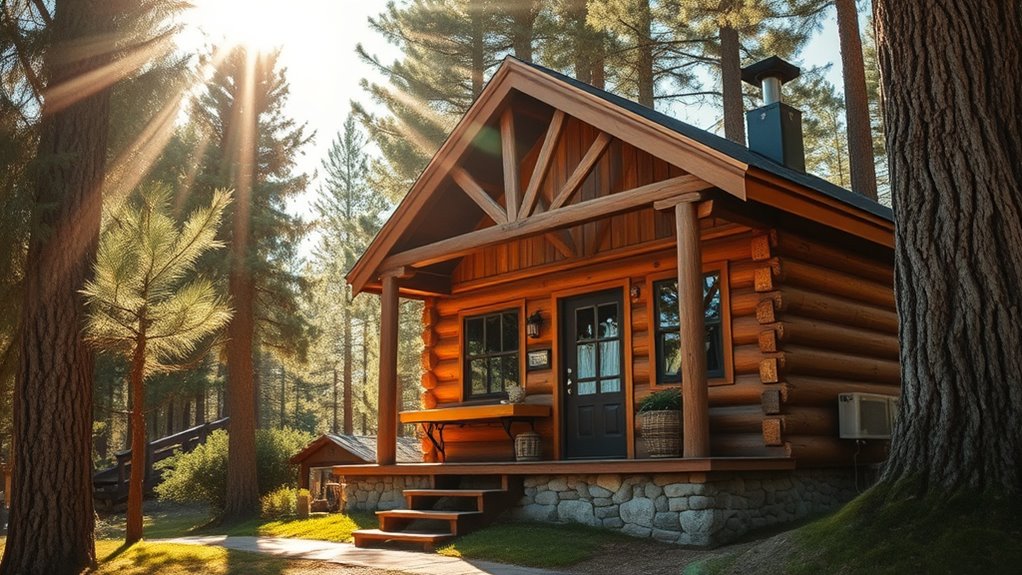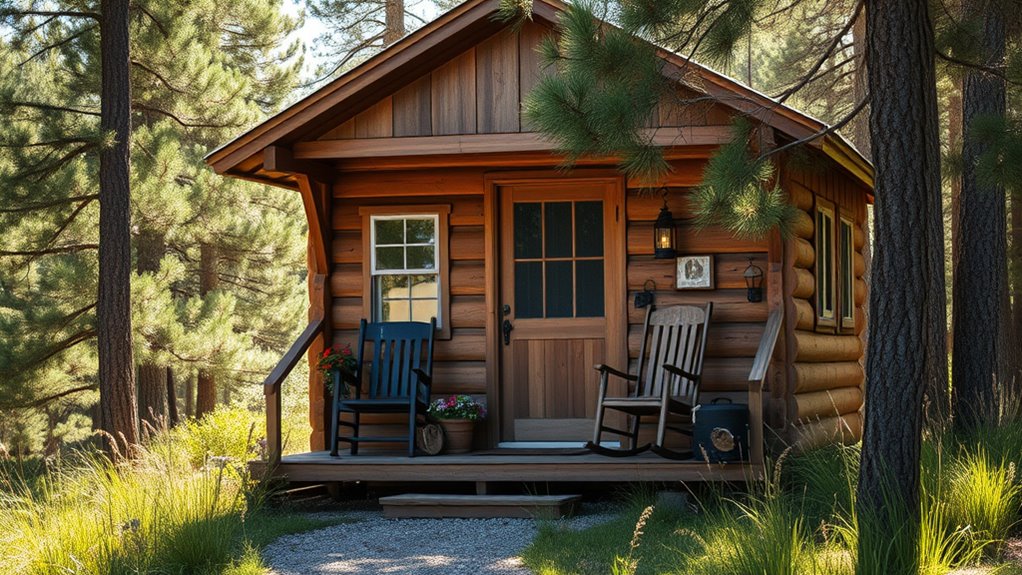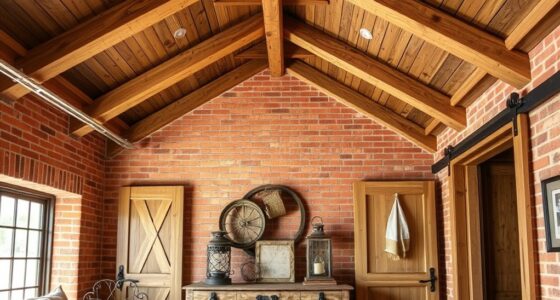To design a cozy rustic tiny cabin, focus on warm earthy colors like soft greens, muted blues, and natural browns paired with wood accents and natural textures like linen curtains, wool blankets, and jute rugs. Use sustainable materials such as reclaimed wood, bamboo, or cork for floors and furniture. Incorporate greenery and simple decor to enhance the rustic charm while maintaining a harmonious, inviting atmosphere. Keep exploring for additional ideas to perfect your cozy retreat.
Key Takeaways
- Use earthy, neutral wall colors paired with warm wood accents to create a calming, rustic atmosphere.
- Incorporate natural textures like linen curtains, jute rugs, and wool blankets for tactile warmth.
- Choose eco-friendly materials such as reclaimed wood, bamboo, and cork to enhance sustainability and rustic charm.
- Integrate indoor plants and greenery to connect the interior with nature and improve ambiance.
- Apply warm LED lighting with minimalistic fixtures to complement the cozy, rustic aesthetic.

Creating a cozy rustic tiny cabin is all about blending simplicity with warmth to craft a welcoming retreat. When designing your space, start with thoughtful interior color schemes that evoke comfort and harmony. Opt for earthy tones like warm browns, soft greens, and muted blues, which naturally complement the rustic vibe. These colors not only create a calming environment but also make the limited space feel more open and inviting. To enhance the cozy atmosphere, incorporate natural textures through textiles and decor, such as wool blankets, linen curtains, or jute rugs. These elements add layers of warmth and tactile comfort, making your tiny cabin feel like a true sanctuary.
Create a warm, inviting tiny cabin with earthy tones and natural textures for cozy rustic charm.
Equally important is your choice of sustainable building materials. Since tiny cabins typically emphasize minimalism, selecting eco-friendly options helps reduce your environmental footprint while maintaining durability and aesthetic appeal. Reclaimed wood is an excellent option for both structural elements and decorative touches, offering character and history to your space. Bamboo panels or cork flooring are sustainable choices that provide insulation and a natural look. Using non-toxic paints and finishes further guarantees that your interior remains healthy and free from harmful chemicals, aligning with the eco-conscious spirit of rustic living. These sustainable materials also tend to age gracefully, adding character over time and reinforcing your cabin’s charming, rustic appeal.
When combining interior color schemes with sustainable building materials, focus on creating a cohesive, harmonious environment. For example, pair warm, natural wood accents with soft, neutral walls to amplify the cozy feel. You might choose a light, earthy hue for the walls, allowing the rich tones of reclaimed wood furniture or exposed beams to stand out. Incorporate greenery through potted plants or small indoor gardens, which not only purify the air but also bring a touch of nature inside, tying everything together. Lighting plays a vital role too; warm LED bulbs and minimalistic fixtures complement the rustic aesthetic while providing sufficient illumination without overpowering the space.
In essence, designing your cozy rustic tiny cabin involves a careful balance of color, material, and texture. By selecting interior color schemes that evoke warmth and pairing them with sustainable building materials, you create a space that feels both inviting and environmentally responsible. Every detail, from the paint on the walls to the wood used in furniture, contributes to the overall warmth and charm. Keep it simple, focus on natural elements, and you’ll craft a tiny haven that’s perfect for relaxing, reconnecting, and truly feeling at home. Incorporating sustainable building materials can also enhance the durability and long-term appeal of your cabin, ensuring it remains a cherished retreat for years to come.
Frequently Asked Questions
What Are the Best Materials for Rustic Cabin Insulation?
You should choose natural materials like sheep’s wool, cellulose, or spray foam for rustic cabin insulation, as they provide excellent thermal efficiency and blend well with interior décor. For exterior siding, use cedar or reclaimed wood to enhance the rustic charm. These materials keep your tiny cabin warm, cozy, and environmentally friendly while complementing the aesthetic you want to create in your rustic retreat.
How Can I Maximize Storage in a Tiny Cabin?
You can maximize storage in your tiny cabin by using smart storage solutions like built-in shelves, under-bed compartments, and wall-mounted cabinets. Incorporate multi-purpose furniture, such as a sofa bed or an ottoman with hidden storage, to save space while providing extra storage options. Using vertical space and choosing foldable or stackable items also helps keep your cabin organized and clutter-free, making the most of every inch.
What Eco-Friendly Heating Options Are Suitable?
You should consider eco-friendly heating options like solar heating and wood stoves. Solar heating harnesses sunlight, providing sustainable warmth during sunny days, while wood stoves use renewable wood fuel, creating cozy heat efficiently. Both options reduce your carbon footprint and are perfect for a tiny cabin’s energy needs. Combining these methods offers reliable, eco-conscious warmth, making your cabin comfortable year-round without harming the environment.
How Do I Ensure Proper Ventilation and Airflow?
To guarantee proper ventilation and airflow, you should incorporate adjustable vents and windows into your interior decor, allowing fresh air to circulate freely. Consider placing outdoor landscaping strategically to promote natural airflow around your tiny cabin. Use ceiling fans or exhaust vents to improve air movement inside. Regularly open windows during the day, and keep exterior trees trimmed to prevent obstructing airflow, creating a comfortable, breathable space.
What Permits Are Needed for Tiny Cabin Construction?
You need to check local building codes and zoning laws before building your tiny cabin. Obtain permits for construction, which may include building, electrical, and plumbing permits, depending on your location. Contact your city or county planning office to understand specific regulations and make sure your project complies. Failing to secure permits can lead to fines or having to modify your cabin later, so start the process early.
Conclusion
As you step into your cozy rustic tiny cabin, the warmth wraps around you like a favorite blanket on a chilly night. Every detail, from the weathered wood to the crackling fireplace, whispers stories of comfort and simplicity. This little haven isn’t just a space; it’s a hug from nature herself. With each visit, you’ll find your soul refreshed, as if the cabin’s rustic charm is softly singing you back to peace and contentment.









